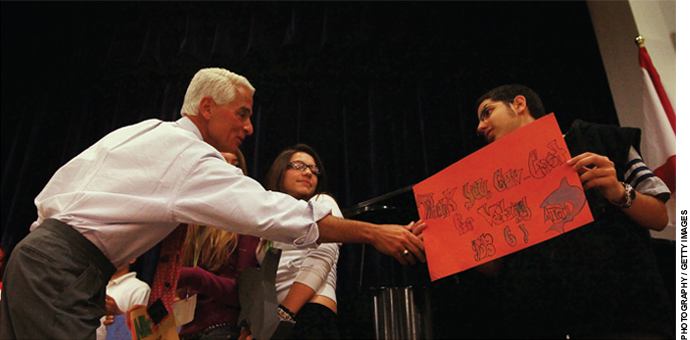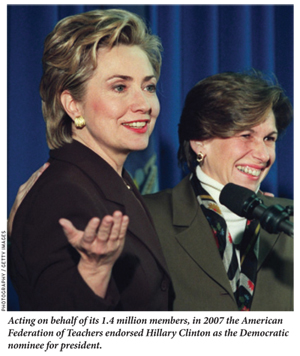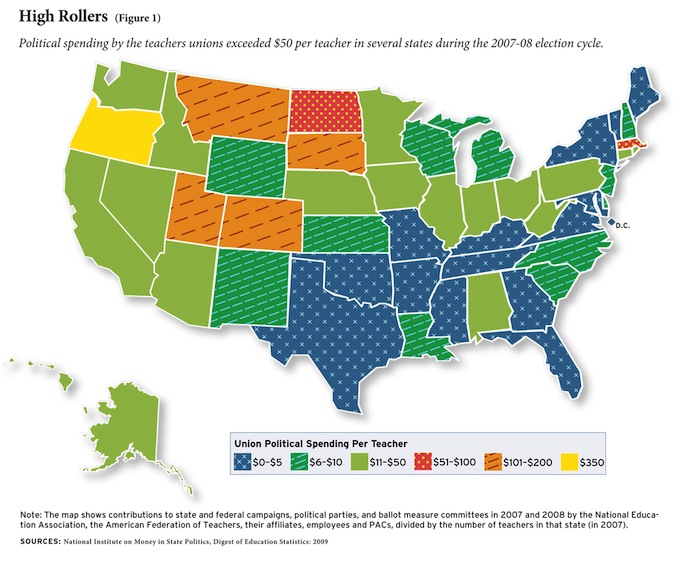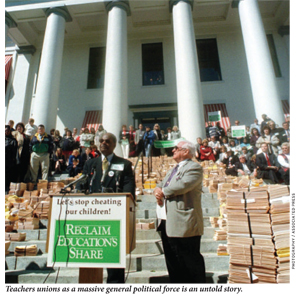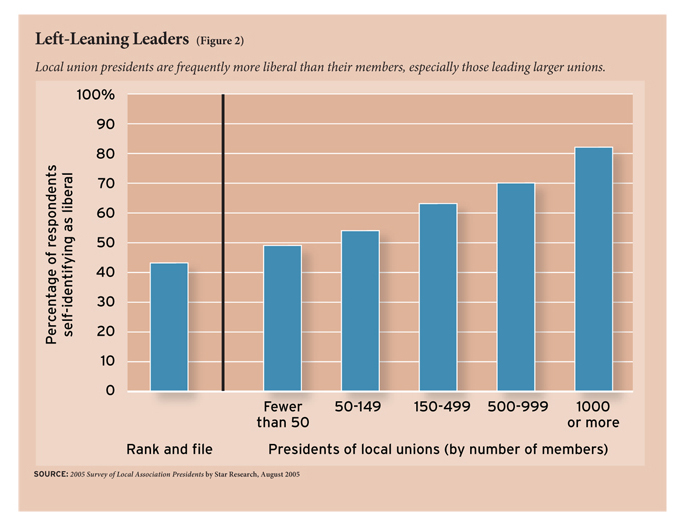When the Florida legislature, on April 8th, passed a bill that sought to replace teacher tenure with merit pay, the Florida Education Association (FEA) sprang into action, organizing members and community activists to lobby Governor Charlie Crist to veto the measure. FEA, with the help of its parent union, the National Education Association (NEA), generated thousands of e-mails, letters, phone calls, and Internet posts in opposition to the legislation. When Governor Crist delivered his veto on April 15th, the union ran television and Internet ads, thanking him. A few weeks later, FEA gave a much-needed boost to Crist’s independent bid for a U.S. Senate seat by endorsing both Crist and Democratic candidate Kendrick Meek.
If you think it’s far-fetched to suggest that a teachers union could play the role of political kingmaker, think again. The largest political campaign spender in America is not a megacorporation, such as Wal-Mart, Microsoft, or ExxonMobil. It isn’t an industry association, like the American Bankers Association or the National Association of Realtors. It’s not even a labor federation, like the AFL-CIO. If you combine the campaign spending of all those entities it does not match the amount spent by the National Education Association, the public-sector labor union that represents some 2.3 million K–12 public school teachers and nearly a million education support workers (bus drivers, custodians, food service employees), retirees, and college student members. NEA members alone make up more than half of union members working for local governments, by far the most unionized segment of the U.S. economy.
The Center for Responsive Politics and the National Institute on Money in State Politics joined forces last year to produce the first comprehensive database of political campaign spending at both the state and national levels. The results should open the eyes of policymakers and educators alike, as well as those involved in the wider world of domestic politics. In the 2007–08 election cycle, total spending on state and federal campaigns, political parties, and ballot measures exceeded $5.8 billion. The first-place NEA spent more than $56.3 million, $12.5 million ahead of the second-place group. That’s not all. The American Federation of Teachers (AFT), the smaller of the two national professional education unions, ranked 25th in campaign spending, with almost $12 million, while NEA/AFT collaborative campaigns spent an additional $3.4 million, enough to earn the rank of 123rd. All told, the two national teachers unions distributed $71.7 million on candidate and issue campaigns from California to Florida, Massachusetts to South Dakota. Millions more went to policy research to support the unions’ agenda.
The teachers unions outspent their union peers by a large margin. The next highest-spending public sector union is ranked at number 5: the Service Employees International Union (SEIU) contributed some $35 million. The AFL-CIO’s largest member union, the American Federation of State, County and Municipal Employees (AFSCME), at less than half the size of NEA, spent about $21 million and ranked 11th.
With such large sums of cash in hand, NEA can involve itself in a wide variety of campaigns in many states without diluting its efforts in any single one of them. During the 2008–09 school year, the national union sent a total of $17.3 million to 24 state affiliates, both large and small. In the case of the large affiliates, this money merely supplements what the affiliate raises on its own. According to a 2010 report by the California Fair Political Practices Commission, 15 organizations spent a combined $1 billion on state campaigns and ballot measures from the beginning of 2000 to the end of 2009. The California Teachers Association (CTA) was the biggest political spender over the period, disbursing nearly $212 million. That’s almost double that of the second place spender, which also happened to be a public employees union. A portion of the funds CTA spent was received from NEA, but the bulk was generated from CTA assessments on California teachers.
In the smaller states, NEA’s political reach is perhaps best illustrated by the campaign against Measure 10 in South Dakota, a state not normally considered a union stronghold. The November 2008 initiative would have banned the use of tax money for campaigns or lobbying and restricted political contributions by government contractors.
NEA contributed $1.1 million to air TV ads against the measure. That amount of money goes a long way in a media market so small. NEA’s state affiliate, the South Dakota Education Association, has only 5,600 active members and could never have appropriated such a sum on its own. It would have required an additional assessment of almost $200 per member. Measure 10 was defeated, prompting its committee chairman to say, “We’ll be able to prepare accordingly next time knowing that the real opposition to ethics reform in South Dakota is NEA union officials back east.”
Legislative and campaign spending is far from the sum total of teacher union expenditures with a political aim. Both NEA and AFT send additional millions to a vast panoply of advocacy groups, coalitions, community organizations, and charities. Along with their statutory role as labor unions and stated role as professional organizations, NEA and AFT fill the role of philanthropic benefactors for a host of causes, most of them left-leaning (see sidebar).
Leaning Left
NEA funds groups that overwhelmingly fall on one side of the political spectrum. Here are a few examples of the organizations, large and small, that benefited from NEA’s largesse, along with the amounts they received and excerpts from their mission statements. Alliance for Justice: $7,000. “Our Student Action Campaign cultivates the next generation of progressive activists and strengthens public interest grassroots advocacy.”
America Votes: $150,000. “America Votes is the centerpiece of a permanent progressive campaign infrastructure nationally and in the states, benefiting hundreds of progressive organizations in both election and non-election years.”
Americans United for Change: $250,000. “Americans United for Change has challenged the far right conservative voices and ideas that for too long have been mistaken for mainstream American values.”
Campaign for America’s Future: $25,000. “At the Campaign for America’s Future, our daily work is to bring about the progressive transformation.”
Center for American Progress: $110,000 (another $10,000 from AFT). “CAP is designed to provide long-term leadership and support to the progressive movement.”
Center for Community Change: $10,000. “We believe that vibrant community-based organizations, led by the people most affected by social and economic injustice, are key to putting an end to the failed ‘on your own’ mentality of the right and building a new politics based on community values.”
Democratic GAIN: $10,000. “Democratic GAIN exists to support the professional needs of individuals and organizations that work in Democratic and Progressive Politics.”
Demos: $5,000 (another $10,000 from AFT). “We publish books, reports, and briefing papers that illuminate critical problems and advance innovative solutions; work at both the national and state level with advocates and policymakers to promote reforms; help to build the capacity and skills of key progressive constituencies; project our values into the media by promoting Demos Fellows and staff in print, broadcast, and Internet venues; and host public events that showcase new ideas and leading progressive voices.”
Media Matters: $100,000. “Media Matters for America is a Web-based, not-for-profit, 501(c)(3) progressive research and information center dedicated to comprehensively monitoring, analyzing, and correcting conservative misinformation in the U.S. media.”
Midwest Academy: $5,000. “Courses and consulting services are designed for progressive organizations and coalitions that utilize civic engagement activities to build citizen power at all levels of our democracy.”
U.S. Action: $203,000. “USAction builds power by uniting people locally and nationally, on-the-ground and online, to win a more just and progressive America. We create the nation’s leading progressive coalitions, making democracy work by organizing issue and election campaigns to improve people’s lives.”
A look at teachers union governance and financing will demonstrate how this philanthropic giving occurs. The school district’s payroll office deducts union dues from each teacher’s paycheck as a lump sum. The money is transmitted at regular intervals to the local union affiliate, which keeps its share and transmits the remainder to the state affiliate, which keeps its share and transmits the remainder to the national affiliate. NEA has an affiliate in every state and claims 14,000 locals. NEA received $162 from each member teacher this school year, and $93.50 from each full-time education support staff member. NEA’s budget for 2010 is $355.8 million.
AFT has a similar arrangement, although its power cannot be wielded as widely since most of its members reside in a single state, New York. AFT receives $190.70 in annual membership dues. The union’s 2010 budget is estimated at $165 million.
NEA spends its money in roughly equal thirds. One-third supports the physical plant and operating costs of the union’s D.C. and regional headquarters buildings. Another third pays the salaries and benefits of NEA’s staff of some 600 employees. The final third is returned to state affiliates in various forms, the largest being UniServ grants. This money helps pay for the labor negotiators and professional staffers employed by the state affiliates.
This third pot of cash also includes money for discretionary spending or, as it is categorized in the union’s financial disclosure report, “contributions, gifts and grants.” Ten dollars of each NEA member’s dues is set aside each year for the national union’s Media Fund and Ballot Initiative/Legislative Crises Fund. The Media Fund pays for national media campaigns and PR grants to state affiliates. The Crises Fund is the primary source of funding for whatever ballot measures or pending bills NEA state affiliates are supporting or opposing each year. Unspent money is carried over, leaving the national union with considerable sums to spend on campaigns in general election years.
The discretionary money is disbursed in a number of ways. The money can be distributed to the state affiliates, which then use it for ballot or legislative battles (see Figure 1, and its underlying data). The national union also makes direct contributions to campaigns or coalitions created around single issues. In the 2007-08 cycle, NEA gave some $17 million to ballot initiative groups in 12 states for a variety of measures related to constitutional conventions, property taxes, income taxes, labor laws, hotel taxes, redistricting, corporate taxes, and vehicle taxes.
More than any other single national entity, NEA is a driving force supporting attempts to raise state taxes, and defeating tax cut or limitation measures. The relative success of the national teachers unions in ballot initiative campaigns and legislative battles can greatly affect a state’s bottom line.
Spin Cycle
NEA and AFT apply their influence directly, through lobbying and election campaigns, but also indirectly via a network of friendly organizations made friendlier through substantial contributions. NEA’s “community outreach” efforts are particularly formidable, gaining the union allies in the fields of research, advocacy, and the media. Through the use of front groups, the teachers unions are able to disguise their role in funding these activities and thus their self-interest in a host of political issues.
The national teachers unions provide generous funding for research that supports their positions on education ($150,000 to FairTest) as well as budgetary issues ($650,000 to the Economic Policy Institute) and social policy ($165,000 to People For the American Way).
For example, NEA contributed $250,000 to the Arizona State University Office for Research and Sponsored Projects Administration. ASU’s Education Policy Research Unit is responsible for a series of highly critical studies of charter schools and vouchers. The unit also annually bestows its Bunkum Awards on think tanks that produce what the ASU panel considers to be the worst research of the year. The “honorees” are almost always conservative or libertarian organizations.
That particular project is “made possible by funding from the Great Lakes Center for Education Research and Practice.” The Great Lakes Center also received $250,000 from NEA (out of a total income of $262,000), but its union entanglements don’t end there.
The press release announcing the center’s launch in September 2000 described it as “a nonprofit tax-exempt organization of education stakeholders with a common goal: the qualitative improvement and healthy growth of all public schools in the entire Great Lakes region. The organization represents a unique partnership between Michigan, Illinois, Wisconsin and other Great Lakes states.” There was no mention of teachers unions, even though the “unique partnership” wasn’t unique at all. It was exclusively a consortium of NEA state affiliates in Michigan, Wisconsin, Minnesota, Illinois, Indiana, and Ohio.
Sixteen of the center’s 17 officers and trustees are NEA national and state officers and employees. The 17th is Alex Molnar, who is, coincidentally enough, the director of the Education Policy Studies Laboratory at Arizona State University.
While the Great Lakes Center keeps its union ties quiet, at least the information is available to those who look for it. Communities for Quality Education (CQE) is entirely an NEA front group, although none of its material, nor any information on its web site, mentions the union at all.
CQE was created as “America Learns” on February 22, 2004, and two weeks later “notified” NEA of its existence and asked for “the largest possible contribution it can to help us launch America Learns and to encourage your affiliates and all members of the NEA family to give as generously as possible.”
Its mission was “spreading the word about the misguided so-called NCLB law, and how to fix it.” This, as it happens, was NEA’s primary focus at the time.
This ostensibly independent organization had a three-member board of directors: Anne Davis, at the time the president of the Illinois Education Association; Robert Bonazzi, executive director of the New Jersey Education Association; and Maurice Joseph, NEA’s deputy general counsel. The executive director was John Hein, who had been the associate executive director of government relations for the California Teachers Association.
By June, CQE had offices, staffers (including NEA employee Corina Cortez), and was airing ads against the No Child Left Behind Act in four battleground states. Many of the teachers featured in the ads were teachers union officers, though they were not identified as such. The cost of the ads: $2.9 million.
How did the fledgling organization come into such cash so quickly? As it turns out, CQE received donations from a number of NEA state affiliates, but the bulk of its funding came from the national NEA turning over its entire media campaign fund of $4 million to CQE. In addition, NEA sent $1.8 million in PAC money to CQE. All told, CQE received $8.9 million in 2004, and there’s no evidence that any of its funding came from anywhere except NEA and its affiliates.
CQE was active in the 2004 presidential election campaign, and the news coverage it received invariably failed to mention its union connections. It continued to receive millions from NEA in 2005 and 2006, mostly to advance the union’s agenda against the No Child Left Behind Act.
In 2007, CQE turned up in Utah, where a referendum was being held to overturn the state school voucher law. A CQE staffer helped organize an antivoucher rally and when asked by the Salt Lake Tribune who was paying his way, he replied, “a variety of sources.” CQE ultimately spent $336,000 on the Utah campaign.
With 2008 being another election year, NEA sent $1 million to CQE, though its activities rarely turned up in press coverage. The organization now seems to be on hiatus, last appearing in February 2009 in support of the Pennsylvania State Education Association’s “Save Pennsylvania’s Schools” campaign, and as the creator of Schoolhouse Talk, an Internet radio show.
The purpose of going to the trouble of creating groups like the Great Lakes Center and CQE is to give the appearance of widespread support for NEA’s education positions. The union’s use of proxies, or subcontractors, if you will, is not limited to that field. Through the generous disbursement of funds, NEA is able to secure the good offices of ideologically compatible groups involved in every domestic U.S. issue (see sidebar).
Beyond Education
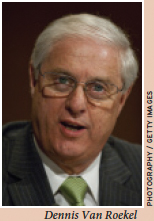 Some of the teachers union donations would not be considered objectionable, regardless of one’s political orientation. NEA gave to All Stars Helping Kids, Boys & Girls Club of the Gulf Coast, Ford’s Theatre, and the U.S. Fund for UNICEF. AFT added donations to Freedom House, Special Olympics, and Vietnam Veterans Assistance Fund.
Some of the teachers union donations would not be considered objectionable, regardless of one’s political orientation. NEA gave to All Stars Helping Kids, Boys & Girls Club of the Gulf Coast, Ford’s Theatre, and the U.S. Fund for UNICEF. AFT added donations to Freedom House, Special Olympics, and Vietnam Veterans Assistance Fund.
Not only did other contributions have an ideological component, they seem rather far afield for teachers unions. NEA gave $150,000 to the Sierra Club and smaller amounts to the American Friends of the Yitzhak Rabin Center, the Hip Hop Caucus, National Immigration Law Center, and the World Outgames. AFT contributed to the American Ireland Fund and the Rainbow PUSH Coalition, as well as to ACORN in D.C. and Maryland.
Two very large donations concerned a noneducation issue on which NEA has been active: health care. The union contributed $450,000 to Health Care for America Now (AFT chipped in another $125,000) and $275,000 to the National Coalition on Health Care (AFT, $10,000). Last year, NEA president Dennis Van Roekel was part of the labor coalition that persuaded the White House to delay the implementation of the “Cadillac” excise tax on health care coverage, but only when it applied to union members.
Are All Teachers Liberal?
Knowing what we do about how various groups line up politically, it probably does not come as a surprise to see a labor union contribute so heavily to progressive groups and causes. The problem is that it should come as a surprise.
NEA members lean no further to the left than any other large group of Americans. The national union conducts periodic internal surveys to ascertain member attitudes on a host of issues. These surveys are never made public, and results are tightly controlled, even within the organization. The 2005 NEA survey, consistent with previous results, found that members “are slightly more conservative (50%) than liberal (43%) in political philosophy.”
The 2009 Education Next-PEPG Survey of Public Opinion (see “The Persuadable Public,” features, Fall 2009) asked public school teachers about their views on education reforms their unions work tirelessly against, among them, charter schools and merit pay. The survey found that more than one-third (37 percent) of public school teachers somewhat or completely support the formation of charter schools, a figure that rose to 43 percent when respondents were told that President Obama supports charter schools. When told that the president supports merit pay, 31 percent of public school teachers express some or complete support for these policies as well.
The obvious question then is, how does a group with a politically diverse membership spend its money almost exclusively in support of liberal causes? And not just on those related to public education, but every conceivable issue?
It may be that the rank-and-file members don’t know anything about NEA’s expenditures. Thirty-six percent of respondents to the NEA survey admitted they were “not at all” involved with the union at any level. The organization has a vast and unending supply of funds from its rank-and-file membership. If members are largely ignorant of or apathetic to where that money is spent, it’s a paradise for a cadre of political activists.
The real solution to the mystery, though, is that NEA’s decisions are made by union leaders, most of whom identify themselves as liberal.
In concert with its member survey, NEA conducted a survey of its local affiliate presidents. The union asked the same political philosophy question of presidents, dividing the results by the size of the local (see Figure 2).
Even among the smallest locals, more of the presidents identify themselves as liberal than do members, and this becomes increasingly true as the size of the unions increases. Though we have no data on the subject, it is likely this trend continues through the hierarchy of the state and national affiliates. Indeed, about 80 percent of local union presidents at each level indicated that they thought NEA’s political philosophy was as liberal as or more liberal than their own. Local union presidents, at least, are aware of the strong liberal bias in the national union’s agenda.
Into the Light
The extent of teachers union influence over education policy is widely known. Education reformers have long recognized the clout of NEA and AFT when it comes to contentious issues like performance pay, charter schools, and testing. School administrators know of their power to affect education budget and personnel decisions. Politicians are aware of their unmatched ability to turn out volunteers for the dog work of campaigning—phone banks, precinct walks, and rallies. Reporters write about all of this.
Yet teachers unions as a massive general political force is an untold story. Rarely discussed is union influence over state and federal elections and over domestic policy, from fundamental issues such as taxation and health care to more esoteric ones, such as gay marriage and redistricting. It’s astonishing that a single organization can spend more than $56.3 million in an election cycle and still fly under the radar.
Part of the reason is that Americans are devoted to their public school teachers. An annual Harris poll routinely lists teachers among the professions Americans most trust (union leaders rank near the bottom). Because they represent people working with children, NEA and AFT benefit from residual good will in a way that the Teamsters and United Auto Workers do not. Press coverage of the teachers unions is usually assigned to an education reporter, which ensures the story will be framed around education issues. It’s only natural that agendas and motives related to the scope of collective bargaining, tax revenue streams, and internal union politics receive short shrift.
Coverage of teachers unions needs to emerge from its current position as an afterthought on the education beat, and assume its place alongside national fiscal and political reporting. Only then will the public see that Big Oil and Big Tobacco have a brother called Big Education.
Mike Antonucci is the director of the Education Intelligence Agency, which specializes in education labor issues.
This article appeared in the Fall 2010 issue of Education Next. Suggested citation format:
Antonucci, M. (2010). The Long Reach of Teachers Unions: Using money to win friends and influence policy. Education Next, 10(4), 24-31.


